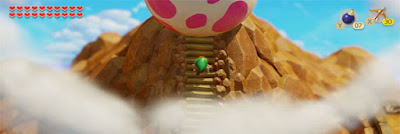Trine follows the adventures of a mage, knight and thief
bound together by a magical artefact known as the Trine. A 2D puzzle platform
game, Trine 2 tries to do something new with a genre more typically found back
in the 16-bit era. Indeed, we found our thoughts drifting to The Lost Vikings
as we began utilising the three hero’s unique abilities.
The knight is best at fighting and can use his shield to
reflect light beams and deflect objects. The thief shoots arrows and can use a
grappling hook and the mage can conjure and move objects. Each character can be
upgraded by seeking out experience points in the form of magic bubbles. This
unlocks further abilities such as exploding arrows, stealth abilities and a
number of other things which help fight off the many Goblins and giant spiders
you'll encounter along the way.
With the different abilities on offer and different ways to
play the developers have given the players multiple options in how to solve the
puzzles. Playing single player has one character on screen which can be changed
at any time, while multiplayer has all characters on screen at once. This means
that certain puzzles would by default need a number of different ways to get
through them.
The great thing is that the Trine world and physics are very
tactile and effectively sets up a big toy box for you play around with to
accomplish your task. Players who prefer the mage will be able to upgrade his
abilities to summon large numbers of boxes and ramps to get around. While those
using a mixture of the characters will find the need to use a combination of
grappling hook swings, magical platforms and brute strength.
You could for instance spend time re-arranging pipes to get
the water level right to reach a high ledge. Alternatively you could use an ice
arrow to freeze the pool and then stack some mage created boxes on it, while in
multiplayer there would be much more opportunity for cooperative lever pulling
. The choice is yours. We found this flexible approach refreshing and it meant
that progression was always steady as you weren’t left searching for the one
way the developer intended you to get through an area.
The first thing that strikes you about the game is just how
jaw droopingly gorgeous the whole thing is. The backdrops and landscapes are beyond
stunning. We have never seen a 2D game that looks so good. Sunbeams shine
through leaves, ice glistens and everything looks as magical and enchanting as
seems humanly possible. The attention to detail is staggering and this combined
with the physics engine creates a solid and immersive world that you never tire
looking at.
The music is also suitably epic with bold fantasy themed
tunes subtly underscoring your adventure. Even better news is that Trine 2 has
an excellent script and group of voice actors. As the heroes adventure their
comments and conversation can’t help to raise a smile. Everything seems to have
been done with just the right amount of tongue in cheek humour.
Graphics and sound are all good but don’t mean anything if
the game doesn’t play well. For the first hour or so we were a little worried
that the controls wouldn’t gel. While we had a few issues when we first started
to play this on the Wii U, the Switch version hits the ground running straight
away.
The game itself is very smooth with everything acting as it
should and combat working well. The only slight issues is that after years of
playing games like Flashback and Prince of Persia we instinctively expect the
edge of a platform to be in a certain part of the graphic. Trine 2’s is a little
deeper and this left us missing jumps a number of times (especially in handheld
mode). Again, once you get used to it there is very little here to complain
about.
This is a good thing as the game is pretty sizeable with the
normal quest taking around ten hours and the add-on content pushing that up by
another five to eight depending how good you are. Searching out all the hidden
chests to get paintings, poems and the maps pieces needed to access the extra
area will also take a fair amount of time.
Every level is strong and there was never a time when we
found ourselves wanting the game to be over. It’s one of those titles that eats
up your free time without you really realising it. When it ends you just wish
there was more of it and we can honestly say this is the most pure fun we've
had with a video game for years.
Everything about Trine 2 just makes us smile and anyone
slightly put off by the fact it’s been around a while really shouldn’t worry.
The amount of value and enjoyment present here is to be commended and it’s
clear the developers really have gone that extra effort to make something that
deserves to be held up with the very best in the genre.
If you haven’t guessed by now we like this game a lot. It
takes players on a magical and beautiful adventure while always remaining
enjoyable and throwing in some absolutely stunning design. If you own a Switch
this game is as essential as anything else you can buy. This is definitive
version of one of the best games to come out in an absolute age and still holds
up expertly. There really is no excuse not to own it.
9/10

























